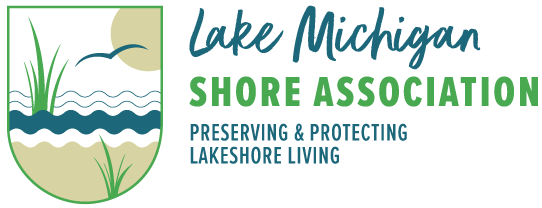STEWARDSHIP OF THE SHORELINE & BLUFF
The LMSA has produced this guideline to encourage “good practices” for the protection of the Lake Michigan shoreline bluff from manmade erosion risks. It is our objective to provide our members with the factors that can cause and often exacerbate bluff erosional processes. We encourage all property owners to become the “stewards” of our cherished shoreline.
Positive Actions You Can Take to Protect the Bluff:
It is our express hope that by sharing this important information we can all recognize the need for careful bluff practices to protect the shoreline entrusted in our care.
LAKE MICHIGAN SHORE ASSOCIATION
- EROSION: The removal of natural bluff vegetation, cutting down trees, bulldozing or degrading dunes and the introduction of pedestrian or vehicle traffic can adversely effect and weaken bluffs and accelerate erosion.
- DRAINAGE: New building construction needs to address drainage issues that can cause infiltration of runoff to weaken the normal cohesive nature of the bluff. Surface runoff from rainfall or snowmelt can remove exposed soil on the bluff and can cause the formation of gullies that swiftly undermine the bluff slope. Paved impermeable surfaces frequently hasten the flow of water and increase the damage from ordinary runoff.
Positive Actions You Can Take to Protect the Bluff:
- VEGETATION: Diverse varieties of plant materials are essential in stabilizing a bluff. The roots of plants assist in removing water from the bluff and play an important role in holding valuable soils in place. Further the canopy created by trees helps to shade the ground during dry spells and helps plants retain soil moisture. Guidelines suggest a wide variety of indigenous plant materials of different sizes and with different growing habits will promote a stable shoreline bluff.
- TREES: The trees planted on a bluff are the pillars of stability that protect a bluff from erosion. It is extremely important to consider the positive effects of trees and their root systems before removing trees. Larger trees will have deeper and better-developed root systems that work overtime to hold the bluff in place. All plants and trees alike absorb great amounts of water and help to prevent surface runoff. It is equally important to think carefully before trimming a tree’s canopy because you will be interfering with the interception of rain. In large rainfalls it is the plant canopies that disperses the water. It has been proven that where trees and vegetation has been removed, even stable bluffs can fail in subsequent years.
It is our express hope that by sharing this important information we can all recognize the need for careful bluff practices to protect the shoreline entrusted in our care.
LAKE MICHIGAN SHORE ASSOCIATION


